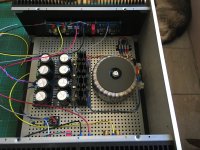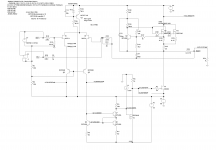Please don't do that. They are so scarce, and you would be leaving two people that actually need the matched quad LSK170s for an F5, F6 or Ishikawa M2X (amongst other projects, probably) without stock. Just be patient!
I think that part of the stock problem is that everyone just snaps out the "wrong" combo to mix and match.
As for a less passionate and more technical plea, if you get 2 sets of mixed quads, your 74s will NOT be matched, so that is another argument to wait for the "actual" package you need.
I think that part of the stock problem is that everyone just snaps out the "wrong" combo to mix and match.
As for a less passionate and more technical plea, if you get 2 sets of mixed quads, your 74s will NOT be matched, so that is another argument to wait for the "actual" package you need.
Please don't do that. They are so scarce, and you would be leaving two people that actually need the matched quad LSK170s for an F5, F6 or Ishikawa M2X (amongst other projects, probably) without stock. Just be patient!
Well, I'd probably put them up on the swap meet.
As for a less passionate and more technical plea, if you get 2 sets of mixed quads, your 74s will NOT be matched, so that is another argument to wait for the "actual" package you need.
Do you need a matched quad? I thought I'd read elsewhere that you only really need matching for each channel.
Buy genuine Toshibas from seller “punkydawgs” on eBay.
Thanks for the tip. Will do!
Nine builds! Sound comparison?
Thanks! Both make nice music. Between the two, my experience is consistent with what NP says about the M2:
Source: https://www.firstwatt.com/pdf/prod_m2_man.pdfNelson Pass said:The auto-former does bring its own signature to the sound, although in smaller doses than we usually experience. The midrange has a lush, warm character that I associate with tubes and transformers, but subtly so.
But maybe I'm only hearing what I expected to hear. Perhaps you'll just have to try for yourself!
Would be nice to measure heatsink temp first and after rotation.
Warm air rises, but what does a heat source mounted on a metal plate? Go more up than down? I’m not sure. If bottom of heatsink is colder, you get a colder airflow bottom to top for cooling? I don’t know.
Wanted to circle back with some interesting data points after rotating my boards. I took 9 measurements with IR thermometer prior to rotating the boards (on each heat sink), as well as the peak on each side. This morning, I took all 9 measurements again, as well as measured the peaks to see the difference in putting mosfets at the bottom of the heat sink.. I'll spare you all the boring location data, and focus on peaks..
Left side of amp: Previous peak temp 122.9f. New Peak: 118.9 = 4 deg f cooler
Right side of amp: Previous peak temp 123.9f. New Peak: 118.2 = 5.7 deg f cooler.
I have to say, I'm completely shocked that these are running that much cooler.. Thanks all for suggesting I rotate them.. It made a big difference!
Next question regarding bias and offset.. I have them pretty close offset 0.0 and bias at 350mv. My bias is wandering a little bit after time though.. For instance I'll set 350 and after an hour or two it'll be down to 340ish and I tweak it back up.. How close should these be, and is a little bit of 'wandering' normal/ok?
Buy genuine Toshibas from seller “punkydawgs” on eBay.
Just done
BOM in progress...
Pass DIY Addict
Joined 2000
Paid Member
Left side of amp: Previous peak temp 122.9f. New Peak: 118.9 = 4 deg f cooler
Right side of amp: Previous peak temp 123.9f. New Peak: 118.2 = 5.7 deg f cooler.
I have to say, I'm completely shocked that these are running that much cooler.
Thanks for your efforts to measure and post the results! I'm always a HUGE fan of actual data! That's quite a nice difference you have there! This is the equivalent of using larger (more expensive) sinks, or a better thermal interface...
As for bias, it will wander as long as temps vary. Let it run for 1+ hours before measuring/adjusting. Then, realize that it will change as soon as you remove the cover, or blow on them, or if the furnace/AC is running, if it is summer vs winter, or you have a ceiling fan running. Get it "close" and then forget about it. The same is true for offset.
It's faaaaar better to relax and contemplate the sound of your favorite music with a glass of wine than worry about bias/offset wandering around by a few mV.
Hi all! I'm new to DIY audio and DIY electronics in general and was hoping for help with a (hopefully) straightforward question re: the Aleph J build.
I realized that the WIMA film caps (0.33 uF) that I bought for C6 are too bulky to slip in-between C6 and B25 on the store's PCB. My first thought was just to extend the cap's leads with some leftover resistor leads. But then I googled extending capacitor leads and found several debates over whether the extra induction from the extra lead length undid the effect of the capacitor in the first place. It also seems like whether that is effect is relevant depends on the capacitance in question.
Would adding ~1-2 cm of length to the leads for a 0.33 uF film cap make it pointless to install in the first place?
Sorry if this is a silly question or if it's already been answered. I tried searching the thread of "C6" but no luck! Thanks for the help; I'm loving my pandemic hobby so far.
I realized that the WIMA film caps (0.33 uF) that I bought for C6 are too bulky to slip in-between C6 and B25 on the store's PCB. My first thought was just to extend the cap's leads with some leftover resistor leads. But then I googled extending capacitor leads and found several debates over whether the extra induction from the extra lead length undid the effect of the capacitor in the first place. It also seems like whether that is effect is relevant depends on the capacitance in question.
Would adding ~1-2 cm of length to the leads for a 0.33 uF film cap make it pointless to install in the first place?
Sorry if this is a silly question or if it's already been answered. I tried searching the thread of "C6" but no luck! Thanks for the help; I'm loving my pandemic hobby so far.
Hey all..
Another Zen Mod AJ nearing completion! I was fortunate enough to be provided a set of ZM AJ boards to participate in an experiment. We'd be attempting to answer the question: Is is possible for a noob to successfully build an Aleph J without excessive confusion, headaches, teeth gnashing, or other calamities?
Yes!! The answer is a resounding YES. Even someone who knows ALMOST nothing can pull this off. Ok, truth be told, I asked a LOT of questions of pFarrell, and 6L6 who were kind enough to answer all my questions.. Boards built up beautifully, were easy to set offset and bias.. and my AJ sounds amazing.
This journey started about a year ago for me with the Whammy. I really enjoyed the build, however I started itching to buy a set of descent speakers and a build a power amp. Patrick and Jim worked tirelessly putting this plan together for me..
I still have to button some things up, the LED wires leading to the front face are really janky and need to be finalized, but I'm absolutely loving the sound. Listening to the AJ via vintage Hersey I speakers, my Whammy as a pre, Schitt Modi DAC, and Tidal for source.
Thanks very much to everyone on this forum.. Particularly pFarrell, 6L6, Zen Mod, and Papa Pass!
What wire gauge did you use for speakers output and PSU? 16 or 14 AWG?
Thanks
Would adding ~1-2 cm of length to the leads for a 0.33 uF film cap make it pointless to install in the first place?
Short answer: no.
Long answer: extending leads of a 330nF capacitor never „undo“ any effect that the capacitor has in a given circuit the PCB tracks might even be longer than that.
Looking specifically at C6 in parallel to C3 - well, there might be discussions whether C6 is needed at all or not
.....But then I googled extending capacitor leads and found several debates over whether the extra induction from the extra lead length undid the effect of the capacitor in the first place. It also seems like whether that is effect is relevant depends on the capacitance in question.
Would adding ~1-2 cm of length to the leads for a 0.33 uF film cap make it pointless to install in the first place?
Sorry if this is a silly question or if it's already been answered. I tried searching the thread of "C6" but no luck! Thanks for the help; I'm loving my pandemic hobby so far.
C6 is not used to decouple the digital circuitry (DAC's) power supply rails, where the extra inductance will most certainly negate the capacitors' capability to decouple the noise from the power supply rails to the ground, especially if we are talking very high sample rates (some people use 1.536MHz these days....
Hence, feel free to extend the C6 leads - C6 is used here (in Aleph J) to couple the audio frequencies - to "help" C3 at high frequencies.
C6 is not used to decouple the digital circuitry (DAC's) power supply rails, where the extra inductance will most certainly negate the capacitors' capability to decouple the noise from the power supply rails to the ground, especially if we are talking very high sample rates (some people use 1.536MHz these days....)
Hence, feel free to extend the C6 leads - C6 is used here (in Aleph J) to couple the audio frequencies - to "help" C3 at high frequencies.
Thanks rollingtube and extreme_boky both. In the interest of not having to take the boards back off the heatsinks in the near future, I went ahead and used the caps I have for C6. Ultimately only needed about 1 cm more clearance. The soldered on leads plus some scrap insulation for stripped hookup wire feels pretty sturdy.
Looking forward to finishing PSU assembly tonight!
Thanks gents.. I have mega pack of fuses on the way. We figured 2A would be a little low, but that's the one that came with the IEC in the store "chassis kit".. I meant to order some additional ones with all of the supplies.. I'll be out of town traveling for a few days anyway, so it's not a big deal! Thanks for the thoughts and suggestions on fuses!
any news?
........
well, I almost forgot
here's what I came with, several nights ago
didn't look at it afterwards, maybe will tomorrow, really interested to see how much stupid details I succeeded to push in
can it be done simpler - yes
is it worth hassle- at all ........ nope - I think
Attachments
- Home
- Amplifiers
- Pass Labs
- Aleph J illustrated build guide

